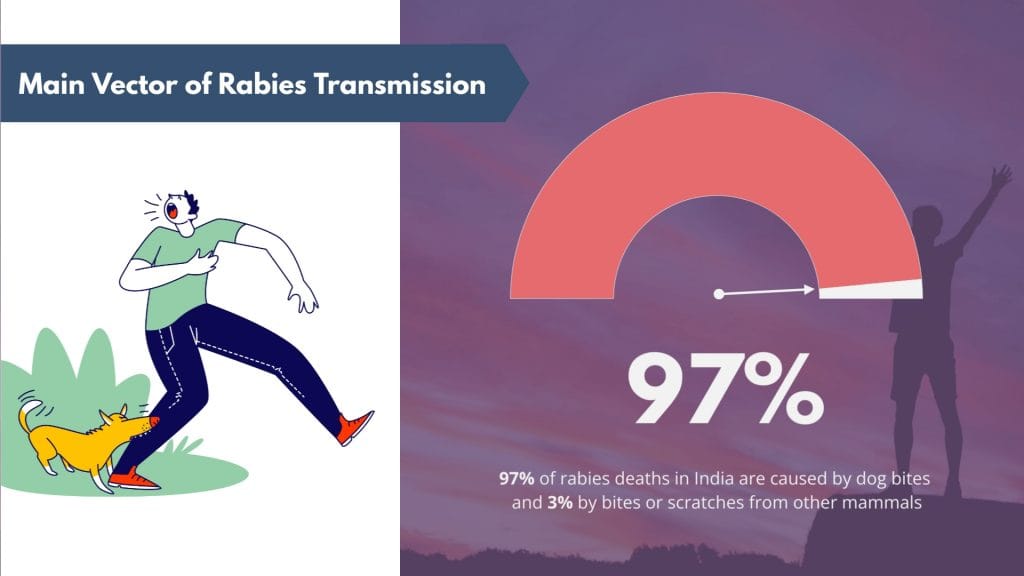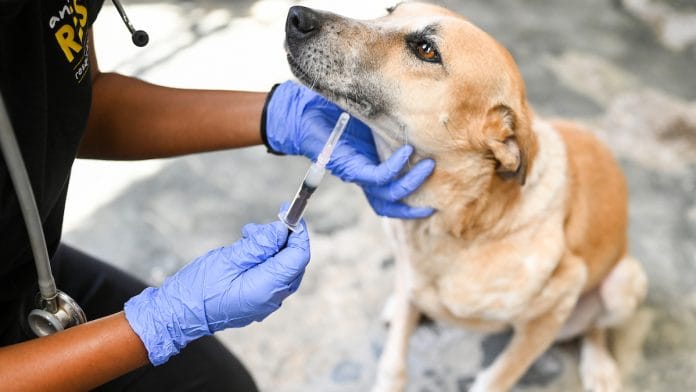It’s late at night, you are walking down a dark street and you see the silhouette of a dog up ahead. You panic a little but tell yourself not to be afraid and keep walking faster. The dog has decided to take on the onus of chasing you away and the next thing you know, you were jumped at and got bitten by a dog! You may have yelled loudly and scared it off, but you are left with a minor wound. What you do next can be a choice between life and death.
The global economic burden of rabies is estimated at US$ 8.6 billion from over 29 million people across the world receiving post-bite vaccinations annually. India is touted to have among the highest human rabies deaths in the world. Notified in fairly recent times, what is India’s plan for capturing key data that will determine the future of whether we will be able to achieve ‘Zero by 30: The Global Strategic Plan’ to end human deaths from dog-mediated rabies by 2030?
Rabies, a silent killer
India accounts for approximately 20,000 rabies-related human deaths each year out of the 59,000 global deaths. Each one of these is completely preventable, but the lack of awareness about rabies and the fear of the series of post-bite injections is still prevalent among Indians, which leads to fatal outcomes for those who are at the receiving end of dog bites.
Ninety-seven per cent of rabies deaths in India are caused by dog bites and 3 per cent by bites or scratches from other mammals. Considering the challenges in accessing healthcare facilities equipped and aware of updated post-exposure prophylaxis protocols, it is often speculated that rabies-related deaths may be going unreported when compared to the number of dog bites reported, which are possibly underreported too.
Individuals and animals afflicted with rabies not only have fatal outcomes but also undergo tremendous suffering as the disease progresses. A rabies-affected human is agonising to watch as they suffer from cerebral dysfunction causing extreme agitation, delirium, violent behaviour, hallucinations, hydrophobia and endless insomnia until death.

Also read: Indians bit off more than they can chew. Many pandemic pet dogs homeless now
Zero by 30
In response to a global call to action made in 2015, the Food and Agriculture Organization (FAO), the World Organisation for Animal Health (OIE), the World Health Organization (WHO), and the Global Alliance for Rabies Control (GARC) developed the country-centric ‘Zero by 30: The Global Strategic Plan’ to end human deaths from dog-mediated rabies by 2030. A country is said to be free of terrestrial rabies when there are zero confirmed cases of rabies in humans, dogs, cats or any other animal species for a period of 24 months.
The responsibility of rabies control
Rabies is a viral zoonotic disease that is transmitted through the saliva or bite of an infected animal. Dogs are the main source (vectors) of human rabies deaths and contribute up to 99 per cent of all rabies transmissions to humans.
According to a survey in 2008, the dog population in India was estimated to be around 2.5 crore. In the past decade with rampant urbanisation, changes in agriculture and a stark rise in the amount of waste we generate, dog populations have risen. Though preventive measures like animal birth control programmes and mass vaccination drives are being conducted by the government and NGOs for over a decade, measurable impact data for the same is hard to find.
It is the Ministry of Health and Family Welfare that has a track record of actively controlling and managing zoonotic diseases like Dengue, H1N1, etc. to reduce human deaths. A progressive decision, rabies was made a notifiable disease in 2021. However, management of dogs, who are proven to be the main vector for rabies disease transfer, falls under the responsibility of the Department of Animal Husbandry and Dairying. The vision, core mission and objectives of the Department of Animal Husbandry and Dairying is focused on growth of livestock, poultry for nutritional security, economic prosperity and livelihood support. They do not primarily work with human healthcare facilities and authorities to have access to determining the true scale of the problem. Additionally, unlike livestock, dogs, owned or unowned, are of no economic value, thus the disease and dog population management is ranked low on the pecking order of public health concerns.
To align India’s goal to the Rabies Zero by 30 programme, the Narendra Modi government announced the National Action Plan for Rabies Elimination (NAPRE) in September 2021. Eradication of rabies relies on a multi-departmental approach as dog populations are spread across different geographies with ownership or the lack of it in almost all socio-economic strata of society.
To analyse and plan appropriate action in order to achieve Zero by 30, NAPRE will need to rely on quality canine and human rabies-related data, which is currently unavailable or sparse. Systematic data collection and analysis are imperative prior to determining an action plan across the diverse locales where the main vector of rabies is spread across. This includes but is not limited to:
1. Dog Population Dynamics and Estimation (DPE) of owned and unowned animals
2. Accurate number of anti-rabies vaccinations and RIG administered annually for humans and canines
3. Current vaccination status of dog populations and sero-level immunity of free-ranging dogs in Rabies hotspots
4. Detailed dog-bite incidents and post-exposure management reports

Also read: Live with bats or kill them? There is a third option even during coronavirus crisis
Piloting a novel rabies-focused data collection system
For data to be accurate and have potential to translate into future implementable actions, it must be collected from the right sources. Possibilities include:
1. Pet registration and licensing programmes: When enforced by local administration, this will provide insight into a city’s pet dog population, vaccination status and reproductive capacity. This will also enable the creation of a database of pet owners so that they can be followed up for yearly anti-rabies vaccination boosters, which is key in rabies control.
2. Data collection at city-level animal control helplines: Information collected at incident reporting and guidance provided about where post-exposure prophylaxis can be obtained.
3. Data collection at public and private hospitals: Information collected at post-incident management level. Data collected accurately at this point will provide insight into cause and category of bites as well as information regarding the type and amount of post-bite prophylaxis vaccine/RIG administered.
4. Animal population estimation drives for unowned/free-ranging dogs: Using newer technology these can be conducted or outsourced by local administration to assess implemented programmes periodically.
Currently, this data is being collected but at different sources by different entities. The methods of data collection are incomplete and lack key data critical to action planning and implementation. A simple-yet-smart data collection system is the need of the hour. A smart data collection system that is user friendly, time-saving and responsive cross-platform is most likely to encourage compliance in data collection across all levels of healthcare workers so that they can enter data accurately and swiftly.
Actualising the Zero by 30 goal for India mandates piloting a smart data collection and reporting system.
Neha Panchamia is Founder and President, RESQ Charitable Trust. She tweets @NehaPanchamia.Views are personal.






